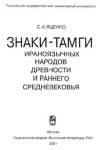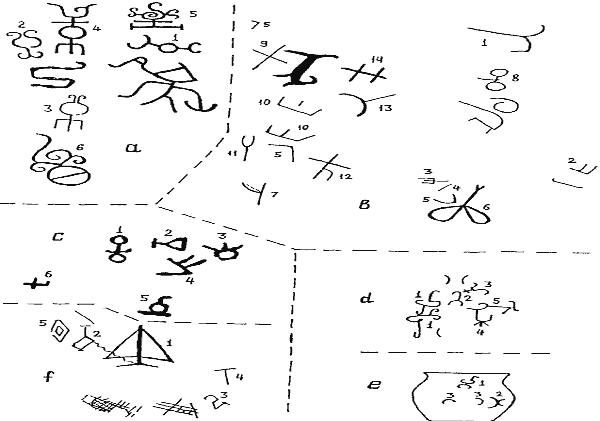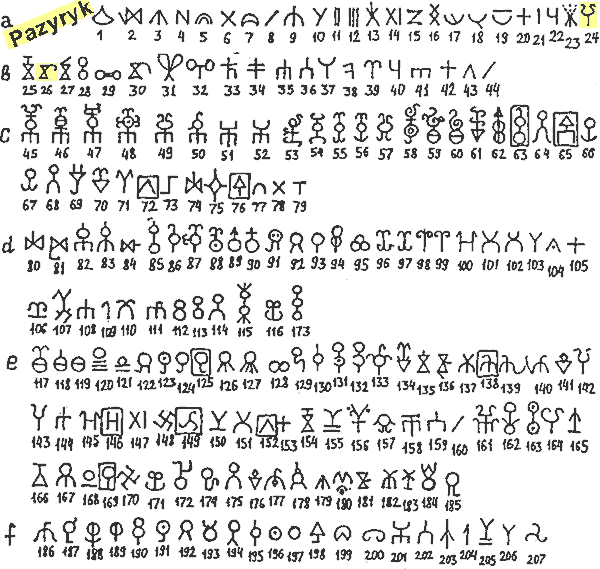|
Home Back In Russian Tamgas Contents Codex of Inscriptions Index |
Sources Roots Alphabet Writing Language Religion |
Genetics Geography Archeology Coins Wikipedia |
Ogur and Oguz Alans and Ases Overview of Sarmatian chronology |
Saltovo-Mayak Culture Codex of Inscriptions-Euro Asiatic-Don Alanian Etymology Notes Alans in Pyrenees |
Alan Dateline Avar Dateline Besenyo Dateline Bulgar Dateline Huns Dateline Karluk Dateline |
Khazar Dateline Kimak Dateline Kipchak Dateline Kyrgyz Dateline Sabir Dateline Seyanto Dateline |
 |
S.A.YATSENKO TAMGAS OF IRANOLINGUAL ANTIQUE AND EARLY MIDDLE AGES PEOPLES Russian Academy of Science Moscow Press ”Eastern Literature” 2001 ISBN 5-02-018212-5 Chapters 9
and 10 |
 |
||||
| <= Previous Section 8 - Persians | Table Of Contents | Next Section 11 - Tamgas Of Middle Age Alans => | ||||||||||||||||||||||||
Selected Quotation |
||||||||||||||||||||||||||
|
|
||||||||||||||||||||||||||
Foreword to the citation of S.A.Yatsenko work |
||||||||||||||||||||||||||
|
Chronologically, Chapter 9 should be Chapter
2, following the introductory Chapter 1. This chapter focuses on the origin center for
the tamga, and had it been in the beginning of the work, it would allow the author to
observe and analyze the spread of the waves westward to the Sarmatian and
Persian world, and eastward to the Sino-Tibetan-Manchurian world. The brevity of
this chapter also does not commensurate with its importance, but on one hand what
would you expect from a person who ventured to seek exclusively the Indo-European
(codeword ”Iranian”) roots, but could not totally escape the Türkic-infected
ancestry, and on another hand this brevity is rather a blessing that would later allow less lopsided analysis, without a drive to sweep
off inconvenient facts, and still on another hand it would allow a detailed research of the clans from
their origin point. The citation of all the petroglyphs and inscriptions and
developments associated with these tamgas would take a lifetime dedication not
expected from a venturer for Indo-European roots, and on yet another hand, the brevity of the chapter is its
beauty, for if you have meat and bones, what else the knowledge needs? Any false
contrivance would be duly discarded sooner or later. If you see that the text and illustrations at times conflict, please do not despair, it could be a typo in the S.A.Yacenko publication, or a misunderstanding on the Translator's part. The tamgas are there, but the illustrations or callouts may be incorrect. A closer look at the maps from which the numbers for the images are cited would help to verify the connections and unconfuse the story. If you see that the text calls Sarmatians ”Iranians”, or their word an ”Iranian word”, do not despair. If this study had ”Türkic-lingual” in its title, it would probably never see the light of the day, and we would have never learnt that the Kangars, Sogdys, Horasmians/Horezmians, Sarmats and Alans had common clans and common clan tamgas, that the royal families of the Horesmians and Sarmatians belonged to the same clans, that the dynasties of the Bospor, Olbia, Bactria were intimately connected all the way up to the Tashkent/Chach by their royal bloodlines, and none of the enigmatic details of these fascinating popular and royal carousels. While the term ”Iranian” pervades the pages of the work as a smell of a dead cat in a high-rise, all the justifications for it are typically contained in these type publications in a footnote 10 on page 13, or even may be hidden deeper in a comment to a footnote 13 on page 10. Like the radioactive potassium in the modern blood testing allows observing bloodstreams and locate diversions, splits and clogs, so the tamgas allow us to see the origins, developments, relocations, activities and final resting places of the people who left for us these remarkable timestamps of their lives. The tracing inherently has an exceeding resolution for insights with increasing magnification, from a tribe level down to the clans, sub-clans, and in places literally down to individual extended families and historical personalities. The day we would find a mummified horse hide marked by a specific tamga with a little tail on it, we would be able to visualize the extent of the possessions of that clan, extent of its travels, its necropolises, and its herds. Just read on! As with the signage traditions of our days, the deviations from traditional orientation of the tamga are irrelevant, like is irrelevant the orientation of a 5-point star on the US emblems, or a 6-point star of the Mogen Dovid, their significance is relayed exclusively by their form and not by the conditions of the object where they are placed. On the other hand, the relative orientation of modifier marks is significant, allowing, for example, to segregate the animals of a ”right hand” family from the ”left hand” family and other kins of the clan, and therefore the mirror images carry discerning connotations. At the same time, an ”assignment” of the tamga would be quite an aberration, like renaming ”McDougall” clan into ”Stuarts”, because every member of the society has his parents, and is destined to carry their tamga to his progeny. This aspect is especially pronounced in the societies where upbringing of the youngsters is traditionally a treasured right of their grandparents. The English rendition of the extensive citation of the work is much simplified, with many details omitted and much reduced references, but with an eye to preserving the logic, facts, and evidence. The citation brings forward the author's comparisons, to allow for easy visual collation of the evidence. A reader should be aware that absolutely none of the dating was performed even with rudimentary scientific instrumentation, and with the exception of the dated coinage, all other dates are within the accuracy of educated opinions, which at times significantly differ, and time to time abruptly change. Any posting's comments notwithstanding, this work is a first major overview of the accumulated research, and we all should be limitlessly grateful for the titanic work performed by the author in researching, assembling and mapping the data, and for many of his insights that lay the ground for the future researchers. The author also notably deviates from the cleansed lexicon that came to use in the Russian academical works of the Soviet period by using Türkic terminology, integral to the Russian language, for the authentic Türkic phenomena, including the very term ”tamga”. |
||||||||||||||||||||||||||
|
Chapter 9 TAMGAS OF SOUTHERN SIBERIA AND (present) MONGOLIA |
||||||||||||||||||||||||||
|
The language attribution of the Southern Siberia tribes and the most part of Mongolia during the Scythian time remains unclear. The Irano-linguality of the Sayano-Altai population can testify direct facts (toponymy, fund of names, specific affinity of folklore), and indirect (presence of common-Iranian dress clothes, headdresses, etc. with specific decor: Yatsenko, 1999; a long list of common with authentic Iranians elements of culture at that time). The majority of tamgas in the region found on petroglyphs, and in many cases there is a question of better dating (this tirade is a beautiful illustration on how the ”science” continues be made in Russia. All stops are pulled on the way to achieve the objective, facts are fast manufactured, and the absolute truth proclaimed any opposing facts notwithstanding. Once the scientific orthodoxy has been demonstrated, the study can turn toward the facts. Compare with V.I. Abaev's discourses. In this particular instance in the author's tirade the trick is that in his comparisons the ”authentic Iranians elements” are least of all "Iranian" - Translator's Note). Interest to these tamgas began from the B.I.Vainberg and E.A.Novgorod's publication of a series of tamgas from r. Tsagan-gol in present Southwest Mongolia, that had direct parallels in the royal tamgas of the Sarmatians, Bospor and Horesm (Vainberg/Novgorodova, 1976, fig. 5) (fig. 34, and see section 6.7). Later, A.P.Okladnikov (Okladnikov, 1980; 1981) published extensive assemblies in other locations of Mongolia, where tamgas were sometimes pictured surrounded identically rendered ”Saka” petroglyphs of the Scythian and later time, on the Tebsh mountain, in the Bikchit, Tayhar-Chulun, Arshaan-shad and others. Similar with the Altai and found in Mongolia tamgas are occasionally found up to the area of Ordos (the ethnic composition of which population during the Scythian time is not determined precisely) (just the opposite is true, see for example, A.N.Bershtam, L.N.Gumilev etc., and the DNA results. This scientific anopia makes science а ”science”. Fortunately, the facts would not be presented if not for a peculiar nationalistic delusion - Translator's Note) (compare a tamga among petroglyphs in the Yinshan mountains abutting Ordos from the north: compare a similar tamga: fig. 35/26). Fig. 34. Collections of tamgas from Mongolia (a, c), Altai (b), W.Turkestan (d-f)
Fig. 35. Tamgas of the Altai (a-b), W. Mongolia (c) and Mongolia (d-f)
Undoubtedly, many such tamgas were inscribed prior to the establishment in the region of
the hegemony of the Hunnu tribe (end of the 3rd century BC)
(i.e. they precede the Karasük Culture, i.e they
originate in the Andronov/Tashtyk period, 1000 -300 BC, before the influx of the
eastern tribes in the Karasük period - Translator's Note).
The tamgas of the Hunnu proper are
almost unknown (probably, the tamgas of their ancestors and themselves are
partially represented in
the tamgas in the present Eastern Mongolia) (i.e. there
are thousands of them, and they are all point blank ”unknown”. Amazingly,
S.A.Yatsenko published in this same work the Hun's tamgas, thank you so much, but was
unable to recognize them. Tochars and Ases, for example, were integrated into the Eastern
Hun society, and followed them to the Eastern Europe, a trek that took 30 generations and
centennial stops at least at three intermediate territories, one of which was the Aral
area studied by S.A.Yatsenko. A good excuse, however, is an absence of a monograph on the
Hun's tamgas - Translator's
Note). The Hunnu tamga are represented, evidently, on the tile of the Chinese-type
building in Khakassia (Kiselyov, 1951, tab. XLV) (which is not
addressed by the author, evidently as completely irrelevant phenomenon outside
of the author's aims, leaving consideration of the subject to future
investigators - Translator's Note). Pazyryk In the Southern Siberia the biggest interest represent the tamgas on the ritual (funeral) wooden imitation of the horse bridles in the Pazyryk culture burials in the Altai Mountain of the 6th-3rd centuries BC (Bashadar no. 2, Pazyryk no.3-5, Shibe) (Poltoratskaya, 1962) (fig. 35, а). There are represented the tamgas of different clans (in Bashadar 11 types, in Tuekta kurgan 1 are 8 types), who were evidently participating in the burial of the noble and furnished sacrificial horses for it. Especially important on that background is Pazyryk, the ”etalon” burial of a noble. There, in every tomb was found a sacrificial bridle with tamgas of only two types (probably, gifts from the clans of father and mother of the diseased). The kurgans 3 and 5 give unique types, and in the kurgan 4 both types are also known in other synchronous burials of the area (kurgan 2 in Tuekta; kurgan 2 in Bashadar). Probably, to the tamgas should be also attributed the various tamgas on the bronze sickles of the Tatar culture (Poltoratskaya, 1962). Among the tamga ”encyclopedias”should be noted the unpublished tamgas on one of two sandstone mengirs (mengir - prehistoric vertically erected stone column, called balbal - Translator's Note) up to 3 m in height, forming a ”gate” in the eastern part of the Sablyk depression in Khakassia, a potential ”pantheon” of the Tagar ”kings” (Kyzlasov, 1986, 139; unpublished material). Not less interesting are two mengirs from the fence of the Big Anhak kurgan, described in the October, 2000 by A.G.Akulov. On one of the sides of each slab are represented not less than 5-6 different tamgas, which usually have analogies in the Sarmatia (see section 6.7). During the Hunno-Sarmatian time in the Altai is known the collection at the Kalgutin mine (Molodin/Cheremisin, 1996, fig. on p. 48) with tamgas, which almost in all cases have analogies with the tamgas of the Central Asia and Sarmatia (fig. 34; see section 6.7). Individual tamgas were marked on the memorial stele near the edge of a kurgan: Pazyryk burials Ulandryk IV (Kubarev, 1987, fig. 3; tab. LXVII) and Bar-Burgazy II in the south of Altai (Kyzlasov, 1997, 179, fig. 6/1) (fig. 35, а/24; b/26). On not too numerous finds of the Altai bone arrows with the tamgas, were documented up to 12 types, sometimes depicted at different angles (Kocheev, 1994, fig. on p. 58) (compare 28/26, 64, 170; 35/11-12, 14-15, 35, 43, 77).
|
||||||||||||||||||||||||||
|
Chapter 10 RELATIONSHIP OF TAMGAS OF IRANIAN AND TÜRKIC PEOPLES |
||||||||||||||||||||||||||
A special foreword to the citation of Chapter 10 of the S.A.YATSENKO work |
||||||||||||||||||||||||||
|
I have not edited the Chapter 10 machine translation below
because, using the favorite expression of Otto J. Maenchen-Helfen,
it is a complete galimatia, written by a party functionary impersonating a
scientist. Both the contents and the form belong to the Russian art of
historiography of the 1930's, when a blatant treading of the party line was a
condition for physical survival, and should have no utility in 2001. The flimsy
arguments are not anywhere close to supporting the weighty conclusions. The author
did not master the specific art of Russian Scientific writing between the lines,
so artfully represented by the talents of
V.I.Abaev, who wrote about a Karvelian language but
to conform to the milieu craftily veneered it as quasi-Iranian. Those who
read Russian, please turn to the Russian citation of the complete and unabridged
original of the chapter in all its splendor. For those who would not endure trying to make sense
of the machine translation, here is a summary: ”This is all Iranian, and
those who disagree are Pantürkists”. In reality, the ”Türks are a small
tribe of a mixed origin, who lived before the middle of the 5th century AD in the mountains of the Turfan
oasis in Sintszyan (Eastern Turkestan), documented by Chinese ”Suyshu””. What can you say? A party line is a
party line, or else. Fortunately, the facts do not need any guiding hand. For convenience, the machine translation and Russian text are given side by side. |
||||||||||||||||||||||||||
|
Chapter 10 RELATIONSHIP OF TAMGAS OF IRANIAN AND TÜRKIC PEOPLES |
||||||||||||||||||||||||||
|
||||||||||||||||||||||||||
| <= Previous Section 8 - Persians | Table Of Contents | Next Section 11 - Tamgas Of Middle Age Alans => | ||||||||||||||||||||||||

